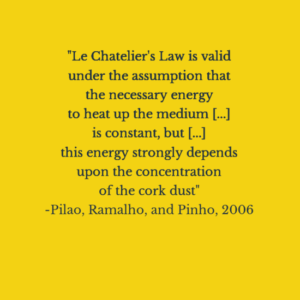1-Sentence-Summary: Addition of methane gas below its flammability limit increases the maximum pressure and maximum rate of pressure rise of cork dust and allows the dust to expload at concentrations lower than its minimum explosible concentration alone.
Authors: R. Pilao, E. Ramalho, and C. Pinho
Read in: Three Minutes
Favourite quote from the paper:

The authors of this paper perform experimental explosion testing in a near-spherical 22.7 L chamber using 2500 J pyrotechnic ignitors. The cork dust has a median diameter of 72.3 μm and tested throughout its concentration range. For hybrid tests methane gas is added in concentrations of 1.98% and 3.5% by volume.
The standard dust explosion testing procedure from ASTM E1515 was used including a total ignition delay time of 0.4 s. A single optical dust probe was used to evaluate the uniformity of the dust dispersion, although this evaluation is not reported in the paper. Explosion pressure verses time, maximum explosion pressure, and maximum rate of pressure rise for pure dust and for hybrid mixtures is reported. The flammability limits for the pure dust, pure gas, and two hybrid conditions are also reported.
Three of the main findings from this paper are:
- The addition of methane below its flammability limit has a much larger effect on pressure and maximum rate of pressure rise for cork dust concentrations of 40 g/m3 than at concentrations of 450 g/m3.
- The lower flammability limit of the hybrid mixture is narrower than that predicted using Bartknecht’s quadratic relation or Le Chaterlier’s Law.
- The likelihood and consequences of a cork dust explosion increases with the presence of methane gas.
The following sections outline the main findings in more detail. The interested reader is encouraged to view the complete article at the link provided below.
Finding #1: Methane gas has a larger impact at lower cork dust concentrations than at higher concentrations
The authors found that the addition of methane gas for dust concentrations of 40 g/m3 greatly altered the pressure-time history of the explosion. Maximum pressure increased from 2 bar for the pure dust test, to 3.1 bar and 4.5 bar for the two gas concentrations, respectively. The maximum rate of pressure rise increased from approximately 5 bar/s, to 20 and 70 bar/s, respectively, under these same conditions. Lastly, the time for the explosion to reach maximum pressure and maximum rate of pressure rise was also drastically reduced.
The impact of adding methane gas at 450 g/m3 was much less than at the lower concentrations. For 1.98% methane, the pressure time trace is relatively unaltered from the pure dust case, with a slightly higher maximum pressure (around 5.8-6.2 bar). The addition of 3.5% methane increased the maximum pressure to 6.4 bar, and the maximum rate of pressure rise from 230 to 320 bar/s.
The justification proposed by the authors is that the explosion is dominated by the dust combustion characteristics at high dust concentrations relative to the gas. At lower dust concentrations the gas combustion characteristics become dominant. Further exploration of the specific combustion phenomena involved remains to be completed.
Finding #2: Hybrid flammability limits for cork dust/methane mixtures are narrower than the predictions of Le Chatelier’s Law
Traditional testing of hybrid mixtures showed wider flammability limits than the prediction of Le Chatelier’s Law. This led to Bartknecht proposing a wider quadratic relationship in his textbook Explosions: Course, Prevention, Protection. At the two gas concentrations tested in the current paper, narrower flammability limits than both relationships were found (i.e., more fuel was needed than predicted by either approach).
In the current paper the cork dust minimum explosible concentration without gas was 42 g/m3, and the lower flammability limit of the gas was taken as 4.4% by volume. Using Le Chatelier’s law the predicted explosible dust concentration for 1.98% and 3.5% methane gas is 23 and 9 g/m3, respectively. However at these two gas concentrations the dust was not found to be explosible until 31 and 20 g/m3 were added, respectively
The authors of this paper suggest two possibilities for the narrowing of the explosion limits over Le Chatelier’s law:
- The first explanation is that Le Chatelier’s Law includes the assumption that the energy required to heat the medium to the ignition temperature is constant for the different mixtures. Pilao, Ramalho, and Pinho suggest that the energy required to heat a dust/gas mixture is strongly dependent on the dust concentration (presumably due to the energy required to heat the dust particles), and that this results in narrowing of the flammability limits.
- The second suggestion is that the narrowing of the explosion limits is caused by differences in ignitability of the gas and dust as opposed to flammability. In this sense more dust is required to have ignition of the mixture than is actually required to sustain a flame if ignition was already present.
Although these suggested mechanisms are very useful insights for hybrid mixture explosibility, they do not appear to explain the previous data in the literature that agreed with Le Chatelier’s Law or Bartknecht’s quadratic relation.
Finding #3: The risk associated with a cork dust explosion is greatly increased by the addition of methane gas below its flammability limit
Both the likelihood and severity of a cork dust explosion are increased by the presence of small amounts of methane gas. When combined with the uncertainty of estimating flammability limits using traditional approaches, hybrid mixtures represent a significant increased risk for processing facilities. The results of this paper have important implications for cork manufacturing industries such as those that produce cork stoppers. In these facilities hybrid mixtures are common, and should be taken into account when determining the risk of an explosion event.
My Personal Take-Aways From
“Explosibility of Cork Dust in Methane/Air Mixtures”
I would recommend this paper to anyone interested in the explosion hazards presented by hybrid mixtures. It shows pressure-time traces, explosion parameters verses dust concentration, and flammability limit plots all in a single article. In general one or more of these are typically omitted from similar articles in the literature.
The explanations of Le Chatelier’s Law and the possible deviations for dust/gas mixtures are also well presented. This article would be useful for anyone in a cork manufacturing industry, or that may have a similar organic dust which may come into contact with methane gas. The authors have also published previous papers looking at the effect of particle size and initial pressure on pure cork dust explosions (e.g., see Pilao et al. 2004 and Pilao et al. 2006)
Full Citation: [bibtex file=references.bib key=Pilao2006]
[otw_shortcode_button href=”http://www.sciencedirect.com/science/article/pii/S0950423005000495″ size=”medium” icon_position=”left” shape=”square”]> > Get The Article[/otw_shortcode_button]
